The price for an Airdog Air Purifier is high but it is worth it! Here’s why:
The problem with most mechanical air purifiers is that they utilize HEPA filters that will degrade. To ensure that our air purifiers are filtering out particles optimally, we need to constantly replace those expensive filters.
After looking around, the Airdog X5 Air Purifier caught my attention because it doesn’t utilize HEPA filters but what the company claims to be a revolutionary filtering technology called “TPA” or Twin Pole Active technology.
Now I have to ask, is this all marketing hype? There is so much marketing going on with air purifiers these days, it arouses my suspicions about them. Therefore, through my personal experience owning an Airdog X5, this review aims to provide useful information to help you make an informed decision whether or not the Airdog Air Purifier is worth buying.
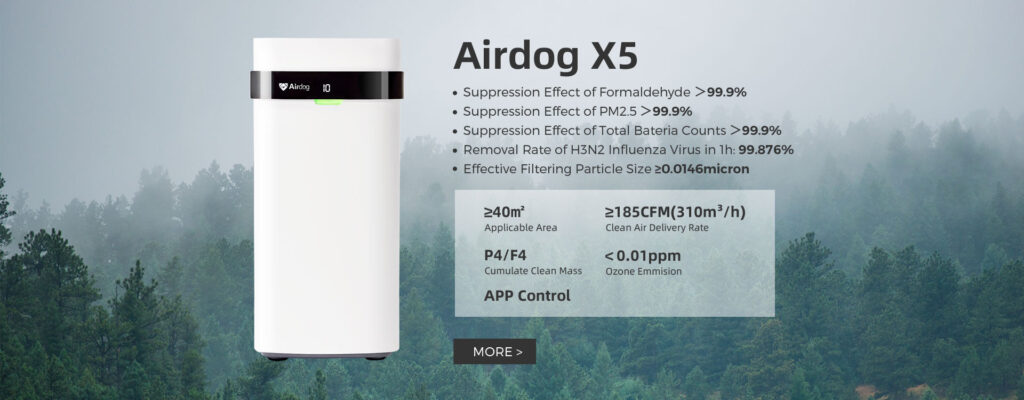
Before I do a comprehensive break down, let’s cut to the chase and ask if the Airdog is actually worth it?
My answer is actually a YES! I recommend it and here’s why!
How Does an Airdog Work?
At first, I was very doubtful with the claims Airdog made through their website. It looks like they try so hard by using fancy marketing terms such as patented Twin Pole Active (TPA) Technology and Ionic wind blah blah. They also claim that their airdog air purifiers can collect and destroy particles as small as 0.014 microns. Frankly, that’s a bold claim that even the best HEPA filters can’t match.
A key selling point for me is the fact that the Airdog air purifier’s filtering system can be reused, saving you money. However, I couldn’t make out how they were able to beat even the best HEPA air purifiers in the market.
The moment I heard the word collecting plates, I immediately knew the Airdog works using a process called electrostatic precipitation and not ionization.
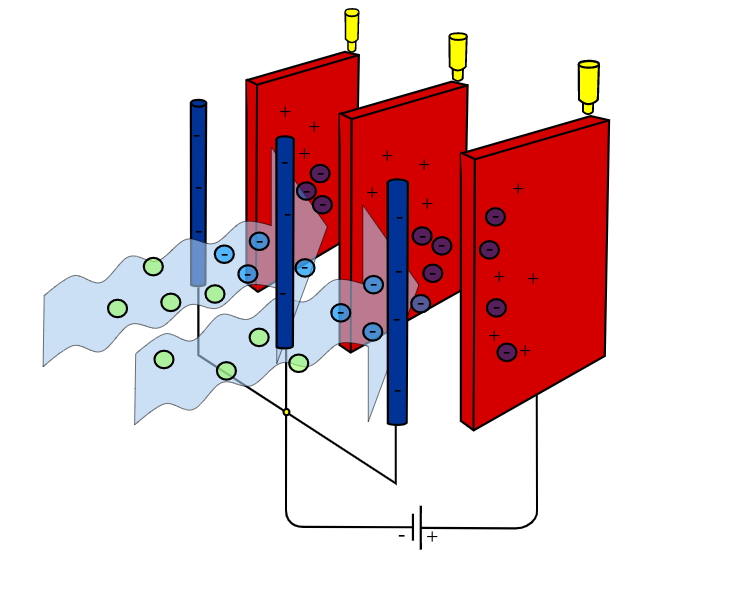
What is Electrostatic Precipitation?
Electrostatic precipitation (ESP) is the process of charging particles flowing in the air to positive or negative and then capturing them with a place containing the opposite charge. In other words, by using static, the airdog’s air purifying system act like magnets to capture tiny particles.
Some will say that the airdog air purifier is an ionizer. That is incorrect because the difference between ionizers and ESP is that ionizers charge particles but don’t collect them. ESPs on the other hand, charge particles and collect them.
Believe it or not, electrostatic precipitation or in short ESP, has been around for nearly 200 years now and today, they are most commonly used in removing industrial fumes from factory smokestacks.
Additionally, a company called Raytheon, or as we know it today as Raytheon Tech (NYSE: RTX), made the first commercially available ESP for the common household in the mid-50s! (See the advert below from Pop Sci)
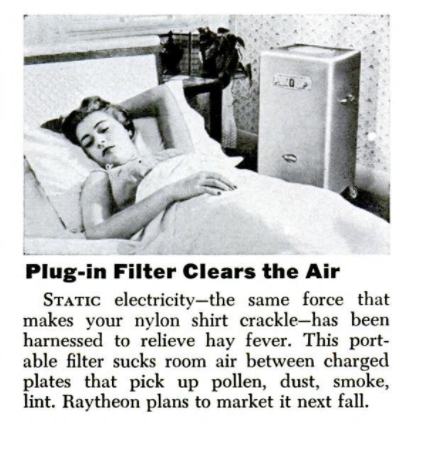
Electrostatic precipitators for residential purposes have been found to be effective against airborne bacteria, viruses, allergens, and gases such as formaldehyde, cigarette smoke, and even car emissions.( Source)
So what makes ESPs different from other air purifiers?
ESPs are different from other air purifiers because they don’t use HEPA filters at all. ESPs charge particles and collect the particles.
With HEPAs, the particles are trapped within the filter. After some time, a collection of particles will buildup on the filter and the filter will need to be replaced to be effective again. Replacing a filter is actually quick and simple. However if you don’t replace filters on a usual basis, the HEPA can work against you by spreading contaminants (i.e. fungi all over the room). (Source) Therefore since the efficiency of HEPA filters degrade overtime, I would like to try something different for a change.
Having researched all of this, the inner-nerd in me thought it’d be nice to have my own miniature and portable version of an electrostatic precipitator at home. So, I bit the bullet and bought an Airdog X5 to see if it works. I am impressed!
First Impressions?
As I have expected, the Airdog X5 is actually a simple version of an expensive industrial electrostatic precipitator. The design is so simple, the Airdog X5 is simply a rectangular plastic box with a strong but silent centrifugal fan that sucks air through its 4 filtering stages.
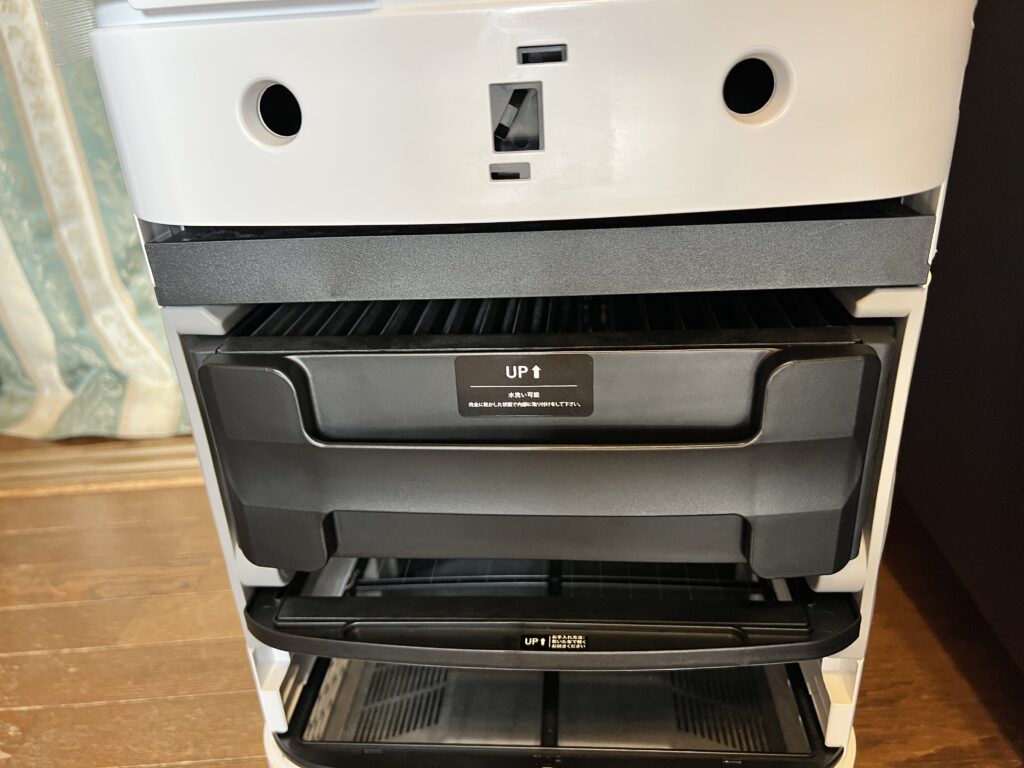
The 4 Stage Filtering Process?
The Airdog X5, has five critical components. Click on the video to learn more!
- The first component is a typical screen that filters out particles that are typically visible to the naked eye.
- The second component is a wire ionizing frame that ionizes particles with a charge passing though it.
- The third component consist of collecting plates that have the opposite charge that collect the charged particles.
- The fourth component consists of an activated carbon filter that removes the ozone and other gases. See more about ozone below.
- The final component is the strong but silent centrifugal fan that sucks the air through the four stages just mentioned.
Sounds cool right? Get up to a $100 off from the Airdog official Online Store.
After 1 Week of Use, Here's what I have to Say:
- Since using an Airdog X5, my sleep quality improved.
- The Airdog has improved the air quality in my home the air somewhat feels lighter and cleaner.
- The built-in Air Quality Index sensor actually works.
- The sleep mode is super quiet and produces very little ambient light that doesn't affect sleep.
- As with other purifiers, the power consumption is low especially on sleep mode.
- The collecting plates are washable and I'm hopeful that this will save me a lot of Benjis in the long run.
*I will continue to update this with both good and bad points as time passes.
Two Cons of the Airdog Air Purifier
- Airdog produces ozone.
- Price is a bit to high for its CADR.
- Need to replace the catalytic filter every year.
Airdog Produces Ozone.
Ozone is a con because ozone can be hazardous to your health. Ozone unfortunately is a product of ionization. According to Airdog and several independent tests, the ozone produced by the X5 is so small, the levels are way below dangerous ozone levels.
Airdog claims that the ozone is filtered out by a "catalytic filter" and the amount of ozone released by the X3 and X5 in a 24 hour period is only 0.01 ppm (part per million) which should not affect you at all. But can we trust what they say?
Furthermore, the "catalytic filter" is just another fancy word for an activated carbon filter. The good news is that activated carbon actually does remove ozone but the bad news is you will have to replace the activated carbon every year or two according to their manual.
One very notable independent certifier I would like to mention that has certified the X5 is the California Air Resource Board (CARB). CARB has certified the X3 and X5 Airdog Air Purifier models as safe to use.
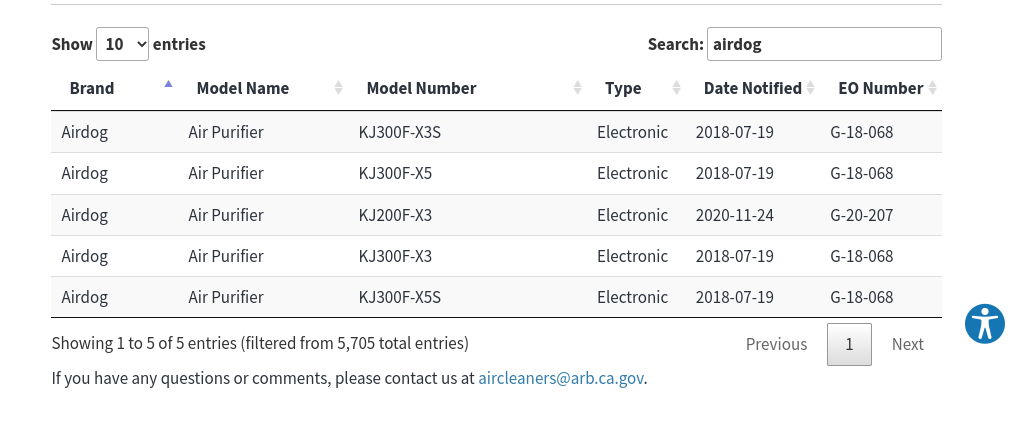
As mentioned on their site:
All indoor air cleaners sold in, or shipped to, California must meet certain ozone emission and electrical safety standards.
The regulation went into effect in 2008 and over 2,300 air cleaners from more than 500 different manufacturers have been certified by CARB for electrical safety and ozone emissions no greater than 0.05 parts per million (= 50 parts per billion (ppb)).
Manufacturers and distributors of air cleaning devices are responsible for becoming familiar with the regulation and meeting its requirements. CARB has active enforcement of the regulation.
So this means that the Airdog X3 and X5 air purifiers should produce less than 0.05ppm (parts per million) of ozone or less in a 24 hour period especially if they want it to be sold in the state of California.
If Airdog is able to get certified by CARB, it's good and safe enough for me to mention and promote on my blog adamgo.com. However, ff you are still not convinced and are concerned about ozone, avoid buying an Airdog and other electrostatic, ionization, and plasma air cleaners and get a mechanical air purifier like the Blueair below.
Just a note: It's strange that the airdog X8 isn't on the list. Maybe its because they haven't tested it yet as it is a newer model? If anyone has info on that, please comment below.
Con#2 The Airdog Price:CADR Ratio Makes it Expensive
The second con is that if you factor in the premium price of $600 usd compared to other air purifiers of the same price range in the market, the CADR is a bit low for the nice price you pay. Usually an air purifier that costs $600 dollars would usually give you about twice the CADR number that you see.
See the BlueAir 211 below. Blueair 211 almost gives you twice the CADR for nearly half the price of the Airdog X5.
The BlueAir 211's CADR is 353CFM for fine smoke while the Airdog X5 is 220CFM for PM2.5 .
Note: CADR stands for Clean Air Delivery Rate and this is one important metric to look at when buying air purifiers. A high CADR indicates a higher efficiency when cleaning air in a certain period of time for a certain size of room. With a higher the cadr, you get to have more Air Changes per Hour (ACH). The Harvard School of Public Health recommends an ACH of 6 or greater for COVID-19 risk mitigation . So that makes it 1 ACH or more for every 10 minutes. If you use a low CADR air purifier for a room that is too large, then you won't be having the recommended ACH.
For reference, here's how to calculate CADR:
CADR (in Cubic Feet per Minute) = (ACH x Room Area x Ceiling Height) / 60
CADR (in cubic meter per Hour) = Multiply what you get above with 1.699 or (CADR in CFM x 1.699)
Therefore, it is wise to get an air purifier that has a higher CADR for it to be efficient in cleaning the air you breathe. So I highly recommend to you buy an X5 or an X8 to overcompensate and get the most optimal ACH.
The airdog air purifier is expensive compared to the CADR of other air purifiers but my argument is that you really can't compare HEPA air purifiers against electrostatic precipitators because they use a totally different filtering process.
So it's like trying to compare a Tesla electric car and a gasoline car.
Con#3 Need to Replace the Airdog's Catalytic Filter
The final con is that this air purifying device is actually not zero cost maintenance.The reason is that it is not really zero cost maintenance is that I strongly suggest that you replace the airdog's catalytic filter (activated carbon filter) every year so that it continues to be effective in removing ozone, TVOCs, formaldehyde, odors, and other gases. As of March 2022, the Airdog X5's catalytic filter costs $49. So that makes it $50 usd in maintenance costs a year for the Airdog X5.
Does the AQI Sensor Work or is it a Gimmick?
In the movie Crimson Tide, Cpt. Ramsey (Gene Hackman) says , "I don't trust air I can't see." and I positively agree. When it comes to some air purifiers, it is sometimes hard to tell if what we buy is a gimmick or not. I have to admit that whenever I use a media-hyped product, our mind can sometimes trick us into thinking that what we buy is actually working because of all the hype.
One actual way to verify if the AQI on the airdog is not a gimmick is to have another AQI sensor and to compare the results.
The Airdog X5 has a built-in AQI sensor and it helps you determine the air quality you have, but what if you don't trust it or what if the sensor is faulty to begin with? The numbers should be similar if not identical.
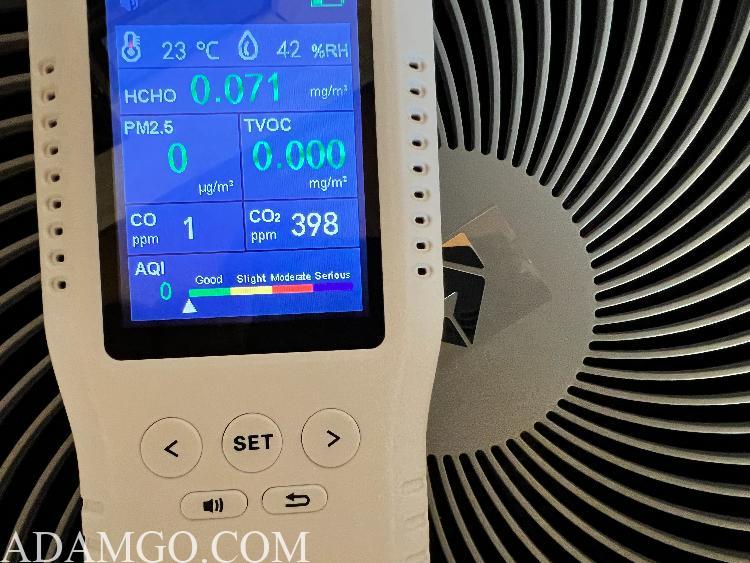
For reference for healthy air:
HCHO (Formaldehyde) should be 0.10 mg/m3 or less.
TVOC (Total Volatile Organic Compounds) should be 0.60 mg/m3 or less.
PM2.5 Should be 50 or less.
Airdog's AQI Sensor Helps Identify Hazards
I like to share that when I first started using my Airdog, my air quality reading was 26. However, I started to notice strange readings notably when using certain appliances in the house.
One night, my Airdog X5 displayed an AQI reading of 175. For a while, I couldn't determine what it was. Was it the roomba doing it's cleaning chores? Was it the heater unit? Was the rangehood running when cooking? Or was it just a scam?
I couldn't pinpoint the culprit until I turned off my humidifier and immediately started to see the number readings go down.
Humidifiers Causes AQI to Spike
As some of may already know, dirty humidifiers cause more harm than good. What taught me a lesson is that even if I clean my humidifiers weekly with a tablespoon of chlorine and gallon of water, this is not good enough. My humidifier was going on it's 5th day of use since being cleaned and I'm already getting a blaring red reading around the 170 range!
I did some research about humidifiers and was appalled on how unhealthy using traditional types of humidifiers can be to your respiratory health even with after just 2 days of cleaning. Even if your humidifier are clean, there is a thing called white dust that ultrasonic humidifiers produce from the water. What is white dust?
I decided to get rid of my humidifiers and order a mist-free humidifier. Until I receive a worthy humidifier, I'll be hanging some wet towels to have some humidity in my room.
Save $50 to buy Airdog's newest mist-free humidifier and get a free hygrometer!Rice Cookers Causes Spikes Too?
As funny as this might sound, my rice cooker causes the AQI on my airdog to spike. I'm not sure exactly why but the highest I ever seen it go was 160 whenever I cook rice with an electric rice cooker. The only thing I can think of is that the cooking of rice produces CO2 (carbon dioxide) which is causing the AQI score to spike??? Or is it a scam?
Again, I'm not sure but if anyone has an explanation, but if you do, please I'm all ears.
Verifiying Airdog's Air Quality Claims on Corona
Now this part is very important. Airdog claims that their air purifiers can filter down to 0.0146 microns or 14.6 nanometers.
A particle needs to be 10μm (microns) or less to be inhaled into your respiratory tract.
According to the National Center for Biotechnology Information ncbi.nlm.nih.gov) , the corona virus is 60 to 140 nanometers or (0.06 to 0.140 microns). With that said, the Airdog should be more than enough to filter out the corona virus.
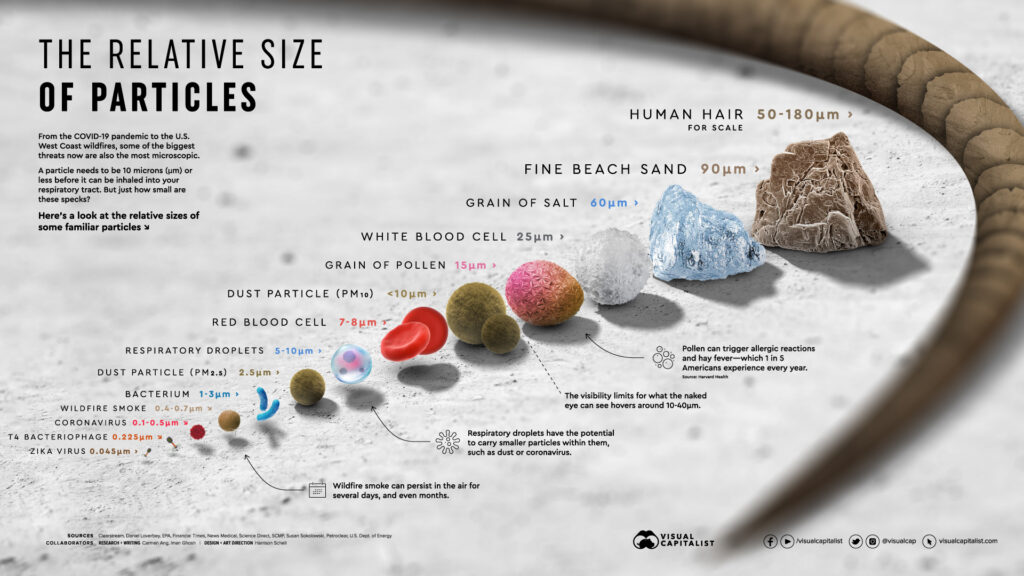
Lots of thanks to the Visual Capitalist, and with their beautiful illustration, we can visualize that 10μm and less is the size of a dust particle PM10, a respiratory droplet, fine dust (PM2.5,) bacteria, smoke, and etc.
Fortunately I found an independent lab study conducted by the Democritus University of Thrace. DUT verified that the Airdog X5 air purifier is effective against COVID-19. The lab study proved that the airdog X5 kills 99.02% (The company Kronos in the article markets its products as Airdog® and KRONOS® brands.)
And here's another article from Forbes that states the Airdog kills 99% of viruses and bio-aerosols. It's nice to know that the Airdog is on Forbes, an authority website, but I'm still skeptical because the problem with this Forbes article is that it doesn't really say who did the tests and it doesn't provide any sources verifying the claims.
Third party lab tests have shown that Airdog X5 kills 99.9 percent of H3N2 viruses in a 30 cubic meter sealed testing room over the course of an hour. The H3N2 virus has the same shape and bio-characteristics as the COVID-19. The high voltage inside the Airdog X5, much like bug zappers, kills and destroys viruses and bacteria.”
https://www.forbes.com/sites/scottkramer/2020/09/13/does-this-purifier-really-remove-covid-19-particles-from-your-home-air/
On Airdog's site, I found these certificates below:
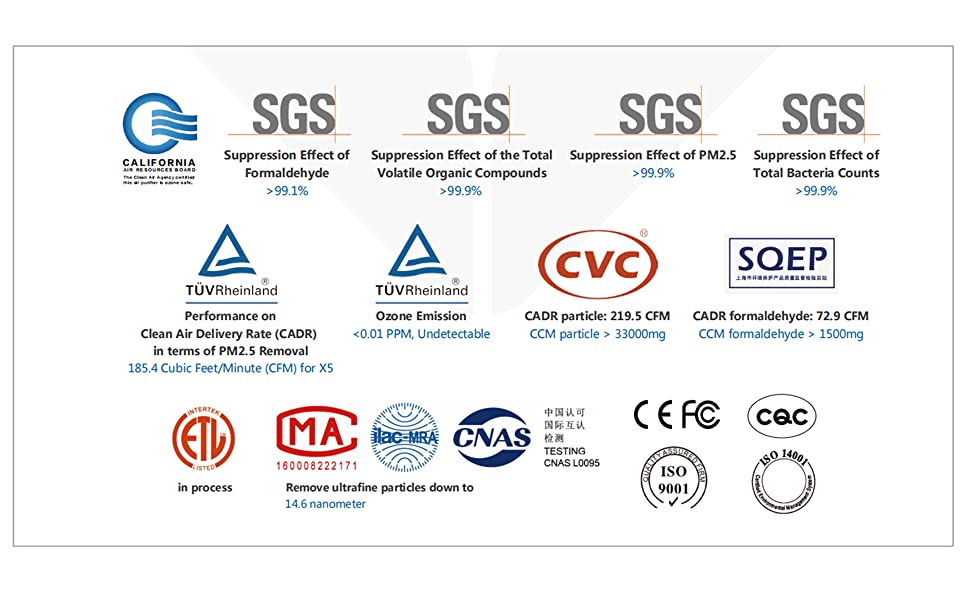
But No Airdog Analysis From the U.S.?
With the exception of ozone analysis by CARB, I could not find any other independent study conducted in the U.S. that claims that the Airdog can filter out 0.0146μm (microns). I wonder why is this?
However, since the Airdog is just like a miniature version of an industrial electrostatic precipitator (ESP), ESPs are already known for being efficient in removing tiny particles i.e. gases and bioaerosols. Also, the Thayer School of Engineering at Darthmouth has studies that electrostatic precipitators removes 99% of particles. (source)
The whole ESP concept of using static electricity to attract micro particles is good enough for me. But, if you're not convinced or not satisfied with your air quality, you can always return the Airdog using their 30-day return policy.
Get up to a $100 off from the Airdog official Online Store.
Maintenance on the Airdog?
Now this is a bit complicated to say if this is a pro or con.
For me, the pro is that you don't need to buy replacement filters for the airdog, making it a very cost effective air purifier.
The con for me is that cleaning the filters can costs you a little time and you have to be a bit delicate. If you are a private practicing doctor or a single dad/mom who doesn't have a lot of time on their hands, you will need to find that extra time (or someone else) to do the maintenance.
According to Airdog, they recommend cleaning the fitlers every 6 months or when the C sign appears. But I like to clean my Airdog once a month. Why? The filters do get dirty very quickly.
After 1 week, here's how my screen filter looks like:
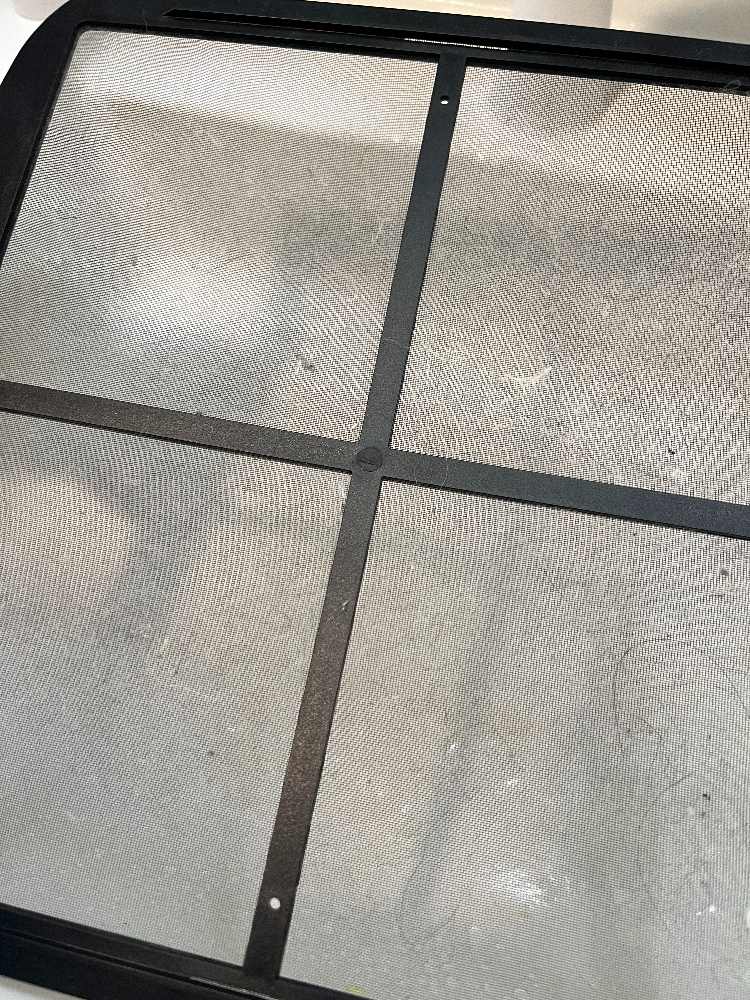
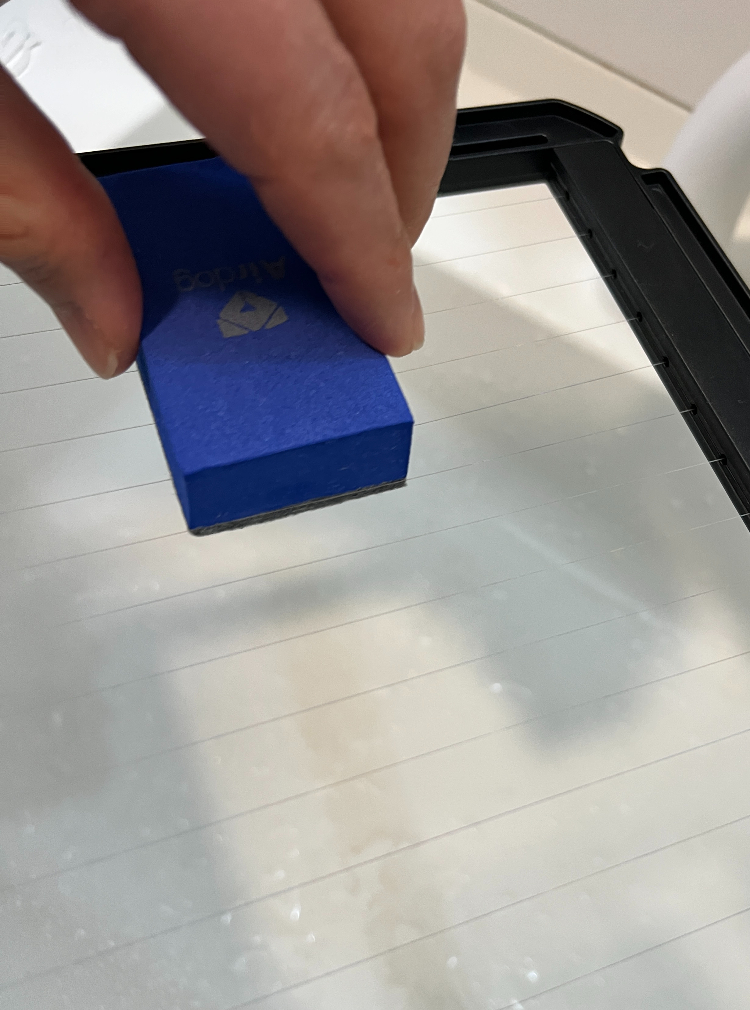
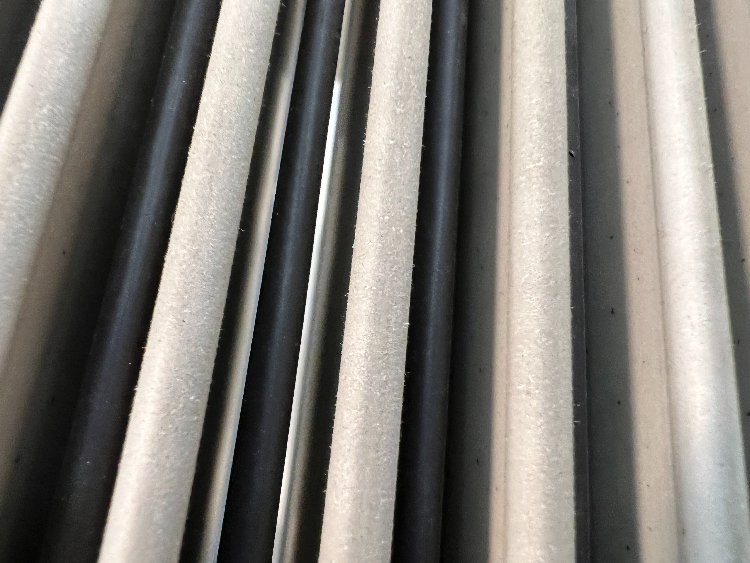
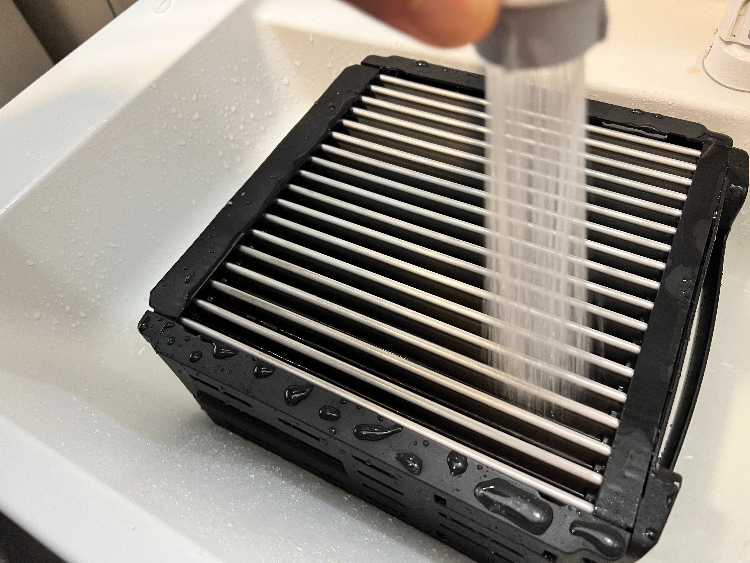
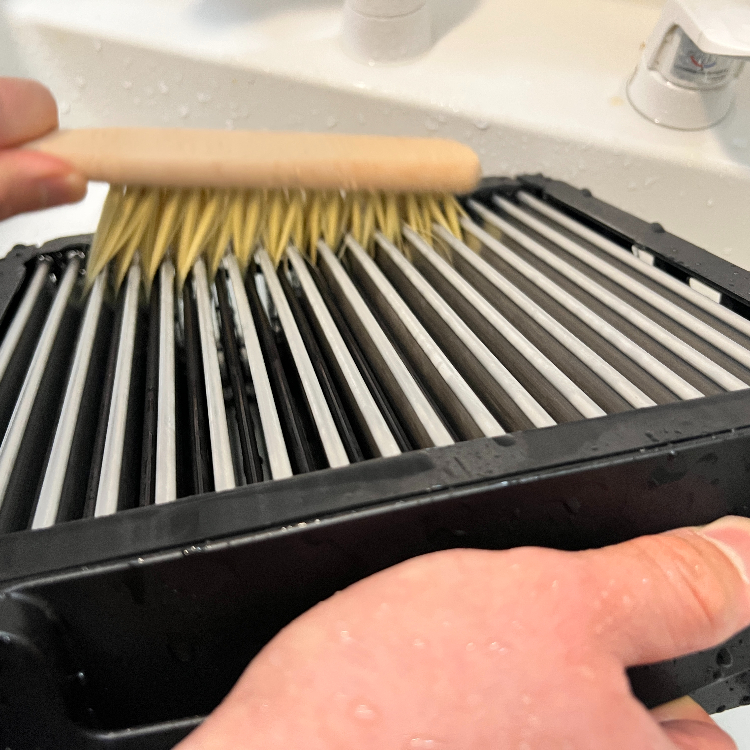
Here are some of my cleaning tips:
- Keep the wires dry!
Use a DRY sponge when wiping the wire filters. Never wet the wires. When you wipe them, place the wires on a flat surface so that you don't snap them. If you are too rough on the wires or get the wire wet, you can damage it. Damaging this filter means you will need a replacement.
2. Be patient when drying the collecting plates.
Another tip is that it takes about 24 or more hours for the collective plates to fully dry after cleaning it with water. You can speed up the process by placing the plates on top of the airdog and running the fan on high to dry.
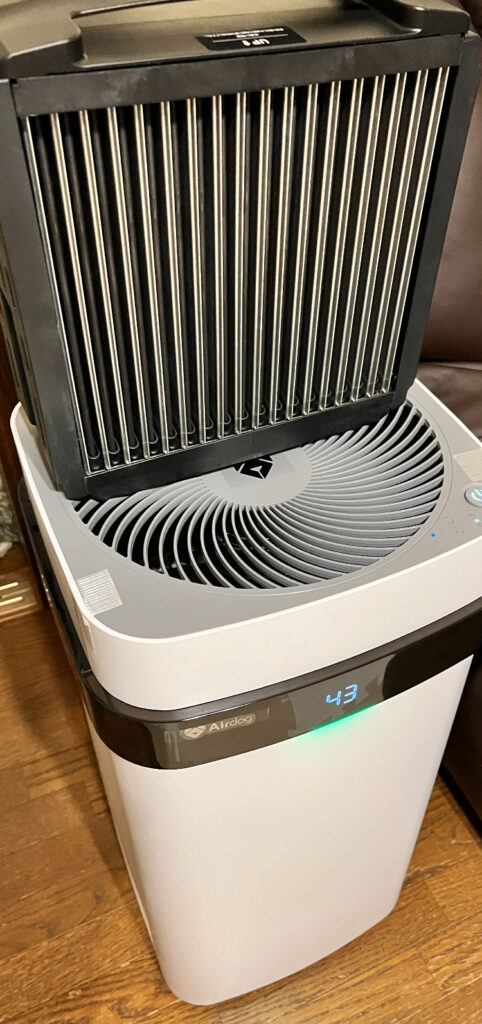
3. Clean the composite catalyst filter with a vacuum cleaner and place it in the sun to dehumidify the carbon.
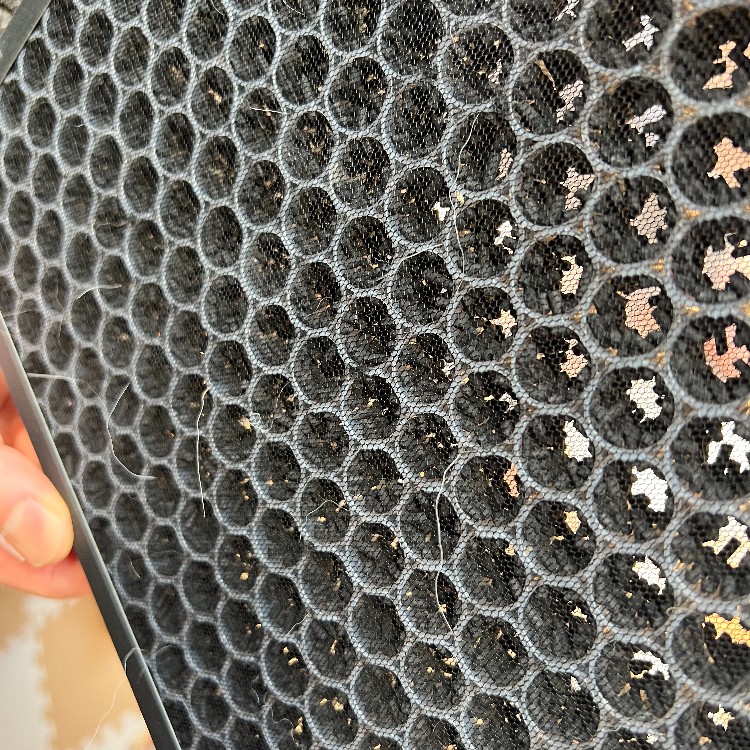
The catalyst filter which again is a carbon filter is something I need to investigate a bit further.
(Update: 3/26/2022)
The Catalyst Filter must be replaced because the activated carbon will lose it ability to filter out odors and even ozone after some time. Furthermore, there are reports that the carbon filter can be reactivated by placing it in the sun. This is false because you need intense heat to reactivate the carbon. Placing in the sun only removes the humidity from the carbon which will allow it to work more efficient than wet. Any how, to stay safe, I would recommend that this single component be replaced once a year to filter out ozone.
Is the Airdog App Necessary To Use?
No. The Airdog app is not necessary. You are able to run the air purifier without having to install it on your phone but you will miss out on some useful features.
Airdog App Unlocks More Features
With the app on your phone, you get to remotely control and monitor your airdog unit from anywhere in the world. My favorite feature is that you can schedule your unit to turn on or off to your heart's desire.
A bonus that I like is the app provides a 15 day record of the air quality in your home so you can track how the air is in your home.
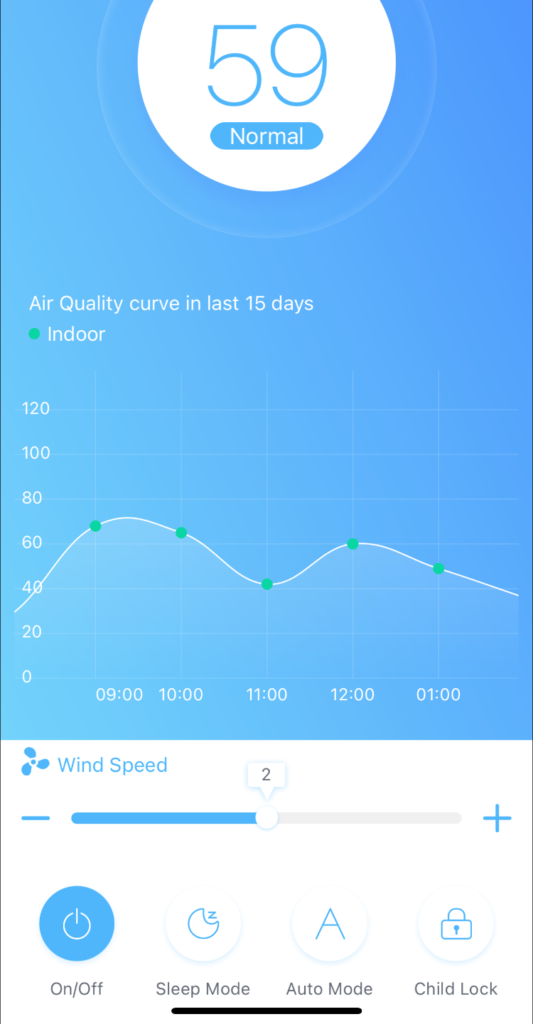
Child-lock function can also be activated with the app or with the provided remote controller.
One last thing. If the AQI number is not easily visible, the app makes it convenient to monitor the AQI and the status of your air purifier.
How to Install the Airdog App?
It's very easy to install but remember that there are multiple airdog apps on the app store, so make sure you download the right one. In my case the app I had to download was called AirdogPro and not Airdog. If you are not sure, just scan the QR code found in the user's manual.
As an experiment I tried downloading a different shady Airdog app that was on the app store and to no avail I couldn't connect at all.
Too Expensive?
If this is too expensive, try going for a DIY Air Purifier.
In other places such as Japan, the pricing for the airdog air purifiers go for three times as much (as of March 2022). Believe it or not, they market the X3 as the X3s and the X5 as the X5s. The letter s according to Airdog Japan stands for special edition (special my ass). Sounds like another marketing ploy because the X5 and X5s are identical. So what gives?
It's way economical to buy from Amazon US! You actually can buy an Airdog X5 and an X8 for the price of one Airdog X5 from Japan. What's going on here?
Final Thoughts?
The Airdog can be a very effective air purifier for anyone to have. Despite the tons of marketing and hype going all over the internet especially by the so called Silicon Valley Experts (they're not even from Silicon Valley), the filterless process called electrostatic precipitation has been proven in the past and is used by heavy industries to remove impurities such as smoke, microparticles, and etc.
Even if the Airdog produces ozone, it is certified by the California Air Resource Board (CARB) assuring that the amount of ozone that is produced by the Airdog Air Purifier is not harmful to our health. However, because of this, I strongly suggest that the Airdog's activated carbon filter should be replaced every year to keep the ozone levels in check.
Even if the price is a bit expensive, especially when factoring the Price to CADR ratio; it is beneficial to my opinion to have an Airdog for homes, hotels, or for the office. And the reason again is, not only will the Airdog remove harmful gases and viruses, the filter-less system can save you quite a bit of money from buying HEPA replacement filters in the long run.
Cleaning out the washable collective plates isn't that bad but can be considered an additional chore. Again, Airdog recommends to clean every 6 months while I recommend cleaning every month.
The airdog app that you can download for free adds more functions such as sleep mode at every fan setting and the ability to set on and off schedules. The airdog app also allows you to control and monitor the AQI anywhere in the world with just your phone. Just remember to make sure you have downloaded the right app online.
Finally, the high price is a bit of a turn off but with a discount, it could be worth every penny!!! If you're going to buy an Airdog, I highly recommend the X5 because I believe it's just right for most people! Here's a discount I can give you:
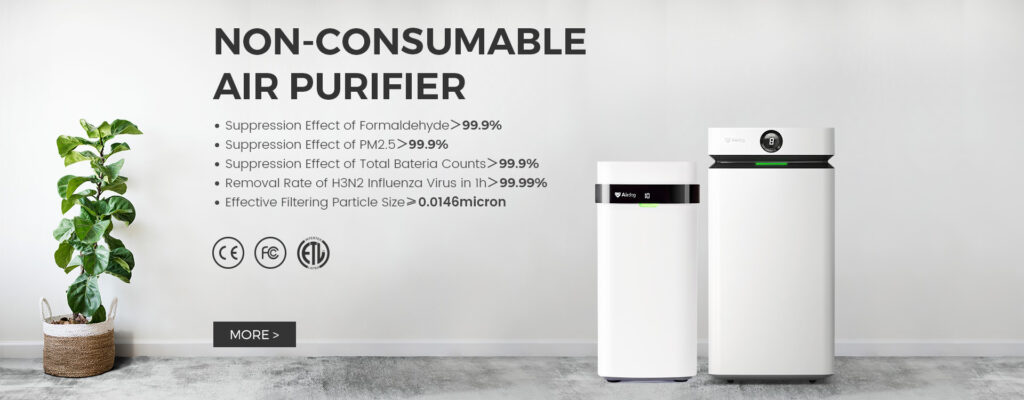
I review worthy products independently but may earn affiliate commissions from links on this page. Thanks for your support! Also, Adamgo.com is a participant in the Amazon Services LLC Associates Program, an affiliate advertising program designed to provide a means for sites to earn advertising fees by advertising and linking to Amazon.com. Buying from my links help make me write more reviews. Thank you! Adamgo.com
This review was first published on 3/17/2022 by Adamgo.






Also, a good point to bring out is that the airdog are not ionizers. An ionizer is different from ESPs because an ionizer does not collect anything. The particles are blown out of an ionizer and stick to surfaces in your home, car, office, and etc. ESPs charge and collect particles as seen in the image above!